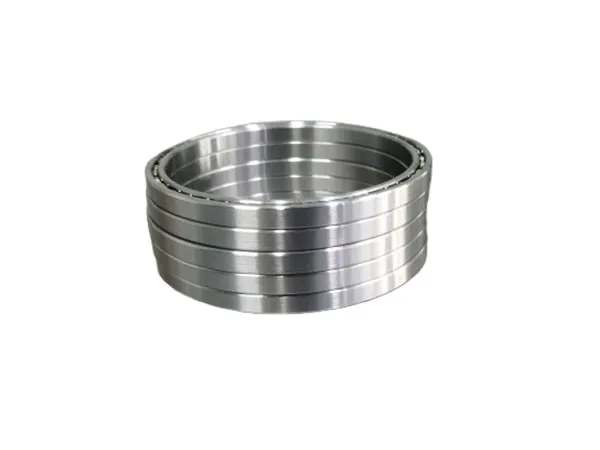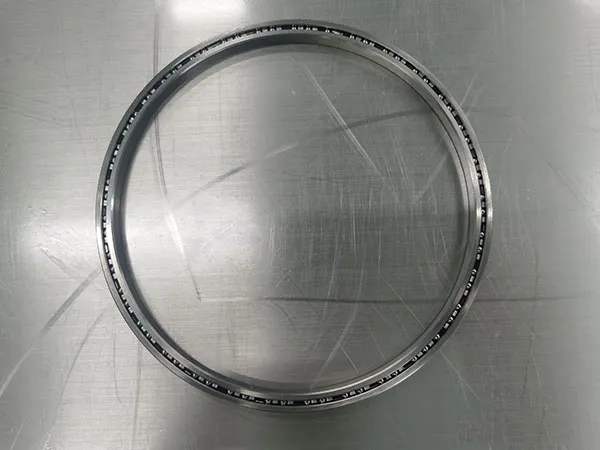Thin-section bearings are becoming increasingly popular in the design of precision machinery and compact equipment due to their unique advantages of lightweighting and space-saving features. However, optimizing the performance of these bearings, particularly how to effectively reduce friction, remains a persistent challenge for engineers. Friction not only causes energy loss but also generates heat, shortens bearing life, and even affects the overall accuracy of the equipment. This article will delve into key strategies for reducing friction in thin-section bearings.

Before exploring how to reduce friction, we first need to understand the mechanisms by which friction is generated. In thin-section bearings, friction primarily arises from the following sources:
Rolling friction: The contact deformation and micro-slip between the rolling elements and the raceways.
Sliding friction: The contact between the cage and the rolling elements or rings, as well as the micro-slip movement of the rolling elements on the raceways.
Fluid friction: The resistance created by the flow of lubricant within the bearing.
Seal friction: If the bearing is equipped with a seal, friction also arises from the contact between the seal lip and the shaft or raceways. Due to the geometric characteristics of thin-section bearings, their small cross-section height and extremely limited radial and axial space mean that any form of friction will have a more significant impact on their performance.
Lubrication is the most direct and effective way to reduce bearing friction. Lubricant selection is particularly critical for thin-section bearings:
Lubricant Type:
Grease lubrication: Most commonly used. Choose a low-viscosity, low-base oil viscosity, and low-shear grease. Examples include synthetic greases containing PFPE (perfluoropolyether) or ester oils.
Oil lubrication: In high-speed or very low-torque applications, oil lubrication offers lower frictional resistance (especially oil mist or oil-air lubrication). The viscous resistance of oil is much lower than that of grease.
Lubrication Quantity: "Less is More."
For thin-section bearings, the initial grease fill is typically 20%-30% of the free space within the bearing. Overfilling can lead to significant churning losses and temperature rise, which in turn dramatically increases friction. For high-speed applications, even "minimum quantity lubrication" or "no-load" starting can be employed, relying on a subsequent centralized lubrication system to continuously supply a very small amount of lubricant. Regular inspection and replenishment of lubricant to ensure cleanliness are crucial for maintaining low friction.
Avoid overload: Ensure that the applied load is within the bearing's rated load range. Excessive load increases the area of the contact ellipse, significantly increasing elastic hysteresis friction.
Precisely Control Preload:
Preload is used to eliminate play and increase stiffness, but it directly increases friction and temperature rise.
Use the smallest possible preload while meeting stiffness and precision requirements.For angular contact ball bearings, consider using a constant pressure preload (such as a spring) rather than a fixed preload. This prevents uncontrolled preload increases as the temperature rises.
The bearing's internal structural design and manufacturing precision have a decisive influence on friction levels:
Raceway and rolling element surface finish: A higher surface finish reduces friction and wear caused by microscopic irregularities and helps form a stable lubricating film. Rolling Element Geometry: Precision spherical or cylindrical rolling elements ensure more even load distribution and reduce localized stress.
Cage Design: Optimizing the cage structure, such as using lighter materials and improving pocket geometry, can reduce the contact area between the cage and the rolling elements or rings, thereby reducing friction. Cages made of Teflon (PTFE) or engineered plastics can also effectively reduce sliding friction.
Radial Clearance Adjustment: Proper radial clearance is crucial for reducing friction. Excessive clearance increases preload, leading to friction and heat generation; excessive clearance can cause vibration and instability.
Even well-designed bearings can experience a significant increase in friction if improperly installed:
Ensure the concentricity of the shaft and housing: Any misalignment will result in additional edge loads on the bearing, accelerating wear and increasing friction.
Avoid rough installation: Use specialized tools for installation and avoid striking the bearing rings to prevent deformation. Controlling Preload: For thin-section bearings requiring preload, the preload should be controlled using precise torque or displacement according to the manufacturer's instructions. Excessive preload is a major cause of friction and heat generation.

Ceramic Rolling Elements: Ceramic materials such as silicon nitride (Si3N4) offer high hardness, low density, corrosion resistance, electrical insulation, and self-lubrication, significantly reducing friction and increasing speed.
Special Coatings: Applying coatings such as DLC (diamond-like carbon) and TiN (titanium nitride) to the raceway or rolling element surfaces can reduce the coefficient of friction and improve wear resistance.
Continuous maintenance and condition monitoring are key to ensuring long-term, low-friction operation of thin-section bearings:
Regular Inspections: Observe the bearing's operating temperature, noise, and vibration. Abnormal increases are often a sign of increased friction.
Contamination Control: Dust, moisture, or other contaminants inside the bearing can disrupt the lubricating film, increasing friction and wear. Using high-quality seals and maintaining a clean working environment are crucial.
Summary and Checklist
To systematically reduce friction in thin-section bearings, you can follow this checklist:
Selection Phase:
Prioritize deep groove ball bearings or angular contact ball bearings.
Select polymer (PEEK/PTFE) cages.
Avoid seals unless necessary, or choose low-friction seals.
Lubrication Phase:
Use a low-viscosity, low-consistency synthetic grease.
Strictly control the grease fill level (~25% of the internal volume).
For high-speed applications, evaluate the possibility of oil lubrication.
Application and Installation Phase:
Calculate and optimize the preload, using the minimum necessary value.
Ensure the machining accuracy (roundness, hardness, and roughness) of the shaft and housing.
Ensure precise alignment during installation.
Adhere to proper installation techniques to avoid bearing damage caused by improper impact.
Thin-section bearings play an increasingly important role in modern engineering. By carefully selecting lubricants, optimizing internal design, ensuring high-precision manufacturing, performing precise installation, considering special materials and surface treatments, and conducting ongoing maintenance and monitoring, we can effectively reduce friction in thin-section bearings, thereby extending their service life and improving equipment performance and reliability. Investing in these strategies will provide your end product with a significant competitive advantage.
Customized Precision Crossed Roller Bearings: Unlocking Maximum Industrial Performance
2025-11-24 10:45How to Minimize Vibration in Precision Crossed Roller Bearings for Maximum Efficiency
2025-11-19 11:19Top 6 Maintenance Tips for Precision Crossed Roller Bearings to Maximize Lifespan and Accuracy
2025-11-15 13:46Step-by-Step Guide: How to Install Precision Crossed Roller Bearings for Maximum Performance
2025-11-09 00:24Address: Lianmeng Road, Jianxi district, Luoyang City,Henan province.
E-mail: info@lynicebearing.com
Phone: +86-379-60689957
If you are interested in our products and services,
please feel free to contact us!
Get in tuch

+86-379-60689957
Lianmeng Road, Jianxi district, Luoyang City,Henan province.